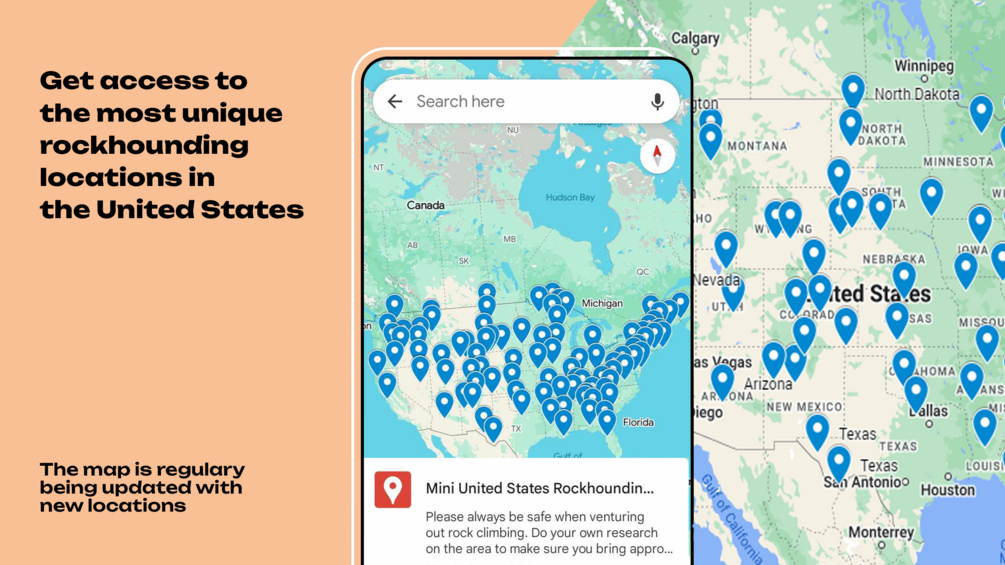Ready to uncover the treasures buried in Arizona’s rugged landscape?
You’re in for a real adventure. Arizona’s diverse geology makes it a rockhound’s paradise, with countless spots to explore and a variety of minerals to discover.
From the fiery reds of Sedona’s sandstones to the gleaming crystals of the Tucson area, you’ll find a wealth of geological wonders. Whether you’re a seasoned collector or a curious newbie, Arizona’s rich terrain is a playground for anyone with a passion for natural beauty.
Let’s dig into the best places to rockhound and the hidden gems you can find in the Grand Canyon State.
Arizona offers a rockhound’s paradise, boasting locations like Quartzsite for quartz and gold, Peridot Mesa for peridot, Holbrook for petrified wood, and Morenci Mine for turquoise and copper minerals. Ensure compliance with local laws, respect private properties, and seek permissions where required. Happy rockhounding in Arizona!
Get our FREE United States Rockhounding Map HERE

Arizona Rockhounding Locations
Embarking on a rockhounding journey in Arizona is like stepping into a treasure trove scattered with jewels just waiting for you to discover. The state’s vast and varied land offers numerous locales, each with its own unique offerings.
Quartzsite
Quartzsite has become synonymous with rockhounding; it’s a beacon for mineral enthusiasts during the winter months when it hosts one of the largest gem, mineral, and fossil showcases. Here you’ll find:
- Quartz
- Gold nuggets
- Agates
- Geodes
Peridot Mesa
Nestled on the San Carlos Apache Reservation, Peridot Mesa is a hotspot for its namesake gem. It’s one of the few places in the world where you can find high-quality peridot on the surface. Be sure to obtain a permit for collecting these green gems as the site is on tribal land.
Holbrook
Holbrook is famous for its petrified wood. You’re virtually guaranteed to find beautiful specimens of this fossilized wonder scattered among the colorful badlands of the Petrified Forest National Park. Although collecting within the park is prohibited, nearby private lands offer legal opportunities to find your own piece of prehistoric forest.
Morenci Mine
As one of the largest copper mines in the country, the Morenci Mine is a source of not just copper, but also:
- Turquoise
- Malachite
- Azurite
Rockhounds need to adhere to safety regulations and seek permission for access, as this is an active mining operation.
The Four Peaks Amethyst Mine
For those seeking the royal purple hues of amethyst, the Four Peaks Amethyst Mine is relatively accessible. With organized mine tours, you can get the chance to find your own Arizona amethyst, a true hidden gem in the desert.
Each location beckons with the promise of a different treasure beneath the surface. As you plan your trips, remember to respect private property, always seek permission where required, and adhere to the Leave No Trace principles to preserve these sites for future generations.
What Gemstones are Found in Arizona?

As you delve into the rich tapestry of Arizona’s geological treasures, you’ll find that the state is a veritable cornucopia of gemstones. Turquoise, revered by Native Americans and gem enthusiasts alike for its vibrant hues, is Arizona’s official state gemstone. Mines in areas such as Bisbee, Kingman, and Morenci are storied locales where this cherished stone has been unearthed.
But turquoise isn’t the only gem that calls Arizona home. The Four Peaks Amethyst Mine, as previously mentioned, produces top-quality amethyst, the state’s signature purple gemstone, known for its deep color and red flashes.
In addition to these, you can find a variety of other alluring gems in Arizona:
- Peridot: This lime-green stone is abundantly found on the San Carlos Apache Reservation, particularly in Peridot Mesa.
- Garnets: Apache tear garnets, which are smooth and rounded, can be collected in areas near Superior and Globe.
- Fire agates: A unique and fiery gemstone that captivates with its iridescent colors, predominantly found in the southeastern region of the state.
Digging a bit deeper, various sites across Arizona also yield jasper, onyx, and chalcedony. Each of these gems carries distinct characteristics, from the translucent hues of chalcedony to the intricate bands and swirls of onyx and the earth-toned shades of jasper.
For those with a fondness for rare gems, the Star of Arizona sapphire is an extraordinary yet elusive find. While not as common as other stones, its allure for collectors is undeniable.
| Gemstone | Known Locations |
|---|---|
| Turquoise | Bisbee, Kingman, Morenci |
| Amethyst | Four Peaks |
| Peridot | Peridot Mesa |
| Garnets | Superior, Globe |
| Fire Agates | Southeastern Arizona |
| Jasper | Various sites |
| Onyx | Various sites |
| Chalcedony | Various sites |
Always ensure you’re equipped with the right tools and knowledge when setting out on your rockhounding journey. Remember, with patience and a little luck, Arizona’s landscapes may yield spectacular gemstone treasures for you to discover.
What Sedimentary Rocks You Can Find in Arizona?

Arizona, a treasure trove of geologic wonders, is not just about the sparkling gemstones. Sedimentary rocks, another piece of the geologic puzzle, are abundant and waiting for you to discover them. Sedimentary rocks are formed through the accumulation and consolidation of mineral and organic particles, and they tell tales of Arizona’s ancient environments.
In the Grand Canyon, you’re looking at one of the world’s finest examples of sedimentary layers. Here, you can marvel at rock formations that feature limestone, sandstone, and shale. These rocks have recorded over two billion years of Earth’s history within their layers. The Redwall Limestone, for instance, is a staple in the Canyon, recognizable by its sheer cliffs and red hue resulting from iron oxide staining.
Nearby the Painted Desert, you’ll encounter the Chinle Formation. This area, known for its multicolored badland hills, offers a view of petrified wood, which is actually silica-rich stone that once was wood, along with layers of mudstone and siltstone. The petrification process preserves the detailed characteristics of the old timber, turning it into a stone replica of its former self.
- Limestone: Used in the construction industry and known for its fossil content
- Sandstone: Porous and often used in aquifers and building materials
- Shale: Source of natural gas and oil
Each rock type stirs the imagination as you think about the ancient rivers, lakes, and seas that shaped them. While you wander through Arizona’s rockhounding paradise, remember each stone beneath your feet showcases a chapter of Earth’s history. Ensure you’re equipped with a good geology hammer and hand lens to take a closer peek at these sedimentary marvels. The fine-grained details and fossil traces within them can give you a firsthand lesson in geology. Whether you’re an amateur or a seasoned rockhound, Arizona’s sedimentary rocks provide a fascinating journey through time and formation.
What Metamorphic Rocks are found in Arizona?
When exploring Arizona’s geological landscape, you’re likely to encounter an array of metamorphic rocks. Schist, gneiss, and marble are some of the metamorphic marvels scattered throughout the state. The process of metamorphism, which involves heat, pressure, and chemical processes, alters the original rock into these unique formations, recording a history of the Earth’s transformations over millions of years.
The central and northern parts of Arizona are particularly known for their schist. This foliated metamorphic rock, often glistening with mica, can be seen near the Grand Canyon and within the Yavapai Schist Province, which extends from the Black Canyon City area to Prescott. Here, you’ll find schist that ranges in age from 1.65 to 1.74 billion years old.
Gneiss, with its distinctive bands and streaks resulting from high-grade metamorphism, is frequently found in the vicinity of the Vishnu Basement Rocks within the Grand Canyon. The bands in gneiss are formed by the segregation of mineral components, and they can tell you about the conditions under which the rock formed.
Perhaps most striking among Arizona’s metamorphic offerings is marble. The Verde Antique Marble quarry near Mayer, Arizona, is especially significant as it supplies a rare type of serpentine marble. This greenish marble is highly sought after by collectors and designers alike.
In addition to visiting these sites, it’s suggested that you equip yourself with a geological field guide. This can help you identify and understand the metamorphic rocks you discover. Always remember to check for any collecting restrictions or required permits, as some areas are protected and collecting is not allowed.
While you’re investigating the diverse rock types available for rockhounding, note that each metamorphic rock you come across has migrated, morphed, and endured extreme environments. Hence, they are not just simple stones but narrators of the Earth’s dynamic history. Keep your eyes peeled for the metamorphic wonders Arizona has in store.
What Igneous Rocks can You Find in Arizona?
As you explore Arizona’s geological richness, you’ll discover a wide array of igneous rocks dotting its vibrant landscape. These rocks are born from the fiery depths of the Earth, solidifying from molten material. Arizona’s volcanic history has left a legacy of igneous formations that are treasure troves for rockhounds like you.
Basalt and rhyolite are two of the most commonly found igneous rocks in Arizona, evidence of the state’s volcanic activity. Basalt, characterized by its fine-grain and typically dark color, is primarily located in the northern regions. Rhyolite, with its lighter color and often flow-banded appearance, can mainly be spotted in the southeastern parts of the state.
In addition to basalt and rhyolite, Arizona is also home to andesite and dacite. These rocks often bear the textures and minerals indicative of their explosive volcanic origins. They can be easily found in areas around old lava flows and extinct volcanoes.
| Rock Type | Common Locations in Arizona |
|---|---|
| Basalt | Northern Arizona |
| Rhyolite | Southeastern Arizona |
| Andesite | Volcanic Fields |
| Dacite | Near Extinct Volcanoes |
For an unforgettable rockhounding experience, you won’t want to miss the San Francisco Volcanic Field near Flagstaff. It’s a prime location where ancient volcanic activity has shaped the terrain, offering up a variety of igneous specimens. Keep your eyes peeled for peridotite nodules, which sometimes contain the gem-quality mineral peridot. Arizona’s iconic Peridot Mesa in the San Carlos Apache Reservation is another hotspot for finding these olive-green gems.
When searching for igneous rocks in Arizona, you’ll often encounter xenoliths—chunks of rock enclosed within another rock. These can be particularly fascinating as they provide clues to the subsurface conditions of the past.
Remember to respect the land and obtain necessary permissions for collecting. You’re not only exploring Arizona’s geological wonders but also stewarding a heritage millions of years in the making. As you hunt for these igneous marvels, consider the violent and fiery origins that forged these stones beneath your feet. Your adventure through Arizona’s igneous landscapes is a journey through time itself, where every rock tells a story of Earth’s fiery past.
Panning for Gold in Arizona
Gold panning in Arizona is an exhilarating experience that can be both fun and potentially profitable. Arizona’s waterways are a primary source for gold prospectors, with a rich history dating back to the legendary 1849 gold rush. As you set out to explore the state’s rivers and streams, you’ll find yourself immersed in the pursuit of finding those gleaming flakes or nuggets.
Prime Locations for Gold Panning
You’ll want to focus your panning efforts on areas known for their gold yield:
- Lynx Creek, a site where it’s legal to pan without any claims
- The Prescott National Forest, which offers a designated area for gold panning
- Wickenburg’s Hassayampa River, famous for its placer gold deposits
Ensure you research whether the land is public or privately owned, claim status, and whether you need any permits.
Techniques and Tools
Successful panning demands patience, along with the right technique. Here’s a simplified process:
- Submerge your pan filled with river sediment into water
- Gently shake it to separate the gold from lighter materials
- Swirl to allow the gold to settle at the bottom of the pan
- Carefully remove other particles to reveal any gold pieces
You’ll need a pan, preferably with riffles, a classifier, and a snuffer bottle for the small particles and flakes. It’s recommended that you start with a plastic pan as they’re lighter and the gold doesn’t stick to them as it does to metal pans.
Tips for a Rewarding Experience
While panning, you’re likely to spend hours bending over water, so comfort is key. Wear waterproof boots, and use knee pads or a cushion. Hydration is vital, as Arizona’s climate can be unforgiving, especially in summer. Always check the weather before heading out.
Remember, while gold panning can yield treasures, it’s also about enjoying the great outdoors and the thrill of the hunt. Amateur prospectors and experienced miners alike celebrate each flake of gold as a testament to their efforts and the Earth’s generous bounty.
Rocks and Minerals Found in Arizona
Embarking on your rockhounding adventure, you’ll be thrilled to discover that Arizona’s geology is as diverse as its landscapes. From the astonishing red sandstone formations of Sedona to the legendary copper mines of Bisbee, the state offers an abundance of mineral treasures.
Turquoise, Arizona’s most well-known gemstone, adorns the state’s rich history. Revered by Native American tribes and contemporary artists alike, this vibrant blue-green mineral is often found in the southwest region where old copper mining operations contribute to its presence.
Equally fascinating is Arizona’s claim to fame as a leading producer of copper. The Copper State’s identity is inseparable from the metallic luster and reddish-brown hue of copper minerals like azurite and malachite. These minerals sometimes occur in the same locales, leaving you with the possibility of a two-for-one find.
If you’re set on sparkling finds, prepare to encounter quartz varieties such as amethyst and chalcedony. Amethyst mines in the Four Peaks region occasionally open for public collection, granting you access to some of the highest quality specimens. And don’t overlook the fire agates—you might stumble upon these iridescent beauties in the desert washes of southwestern Arizona.
To give you an insight into the vastness of Arizona’s mineral offerings, here’s a snapshot of what else is out there:
- Petrified Wood, primarily in the Petrified Forest National Park
- Garnet, found in the spessartine form in Apache County
- Peridot, on the San Carlos Apache Reservation
- Wulfenite, notable from the Red Cloud Mine in La Paz County
Each location presents a unique set of conditions and regulations, so make sure you’re informed and prepared before heading out. Whether you’re scouring riverbeds or scaling mountains, always adhere to the land’s rules and respect its natural state.
In Arizona, every rockhound’s journey is peppered with the possibility of unearthing a hidden gem. Keep your eyes peeled, and your hammers ready, as you explore one of America’s most fertile grounds for rock and mineral enthusiasts.
Where Can I Find Fossils in Arizona?
Arizona isn’t just rich in minerals and gemstones; it’s also a fossil hunter’s paradise. Your exploration for the remnants of prehistoric life may lead you to discover petrified wood, dinosaur bones, and a myriad of other fossils throughout the state.
One of the most famous places to find fossils in Arizona is the Petrified Forest National Park. Located in the northeastern part of the state, this park is renowned for its vast amounts of beautifully colored petrified wood. Here you can walk among the fossilized remains of ancient trees that date back over 200 million years to the Late Triassic period.
Moving onto the northern region, near Page, you can find marine fossils. This area was once underwater, and as a result, it’s common to stumble upon fossilized shells and coral. Pay attention to the rock formations as these silent storytellers can reveal much about Arizona’s prehistoric landscapes.
If you’re in search of dinosaur tracks, head to Tuba City where the Moenkopi Plateau offers a rare opportunity to walk in the footsteps of dinosaurs. While you can’t take the footprints home, the experience is monumental and adds to your understanding of the incredible diversity of Arizona’s geological past.
For trilobite enthusiasts, the House Range in Western Utah is not far from the Arizona border and it’s a well-known spot that extends your potential findings into invertebrate territory. Here, you may spend hours scouring shale formations for these ancient arthropods.
Remember, while you hunt for fossils, you must adhere to local laws and regulations. Collecting in National Parks is strictly prohibited, and always get permission if you’re on private land.
- Petrified Forest National Park: Petrified wood
- Northern Region near Page: Marine fossils
- Tuba City: Dinosaur tracks
- House Range, Western Utah: Trilobites
Besides these locations, there are various other sites scattered across Arizona where fossils lie waiting to be uncovered. Keep in mind that part of the excitement of fossil hunting lies in the search, the landscapes you’ll traverse, and the history beneath your feet.
Arizona Rockhounding Laws & Regulations
As an avid rockhound, it’s crucial to understand the laws and regulations governing your hobby in Arizona. Ignorance isn’t just risky; it can lead to hefty fines or legal issues. The state has specific rules for collecting on public lands and these vary depending on the type of land: Bureau of Land Management (BLM), National Forest, State Trust, or private property.
Firstly, on BLM Land, you’re generally allowed to collect rocks and minerals for personal use without a permit. However, there are limits:
- Reasonable amounts typically up to 25 pounds per day plus one piece
- Not for commercial purposes
- Hand tools only to prevent significant surface disturbance
National Forests are slightly different. You’ll need to check in with the local Forest Service office. Some areas may be off-limits or have restrictions, so it’s wise to inquire beforehand.
When it comes to State Trust land, a recreation permit is required. This permit allows for casual collection, but again, there are restrictions:
- No use of motorized equipment
- Only collect samples that don’t disturb the land significantly
For private property, you must obtain explicit permission from the landowner. Trespassing to collect rocks is illegal and respecting owner’s rights is non-negotiable.
Another key area to be aware of is designated wilderness areas, national parks, and monuments where collecting is typically prohibited. Remember to always research the specific regulations for the area you plan to explore.
While rockhounding, you’re also expected to follow the “Leave No Trace” principles. These practices minimize your impact on the environment and ensure the preservation of natural habitats:
- Plan ahead and prepare
- Travel and camp on durable surfaces
- Dispose of waste properly
- Leave what you find
- Minimize campfire impacts
- Respect wildlife
- Be considerate of other visitors
Protecting Arizona’s remarkable landscapes is a shared responsibility. Staying informed and adhering to the applicable laws and regulations will help keep this hobby sustainable for generations to come.
Rockhounding Tips for Beginners in Arizona
Gearing Up: Essential Tools for Rockhounding
Before you set out on your rockhounding adventure, make sure you’re well-equipped. Proper gear is essential for a successful trip. You’ll need:
- A rugged rock hammer, which is indispensable for breaking rocks and prying specimens from the earth
- Chisels and picks of various sizes for excavating and splitting rocks
- Safety goggles to protect your eyes from flying rock chips
- Durable gloves to safeguard your hands against sharp edges and rough surfaces
- A sturdy backpack to carry your finds, as well as water and a first aid kit
Additionally, consider investing in a good field guide that’s specific to Arizona geology and rock identification.
Safety Tips While Rockhounding
Safety comes first, always. To ensure you have a safe rockhounding experience in Arizona’s great outdoors, follow these guidelines:
- Always let someone know where you’ll be and when you expect to return
- Be aware of the weather conditions, and prepare for sudden changes, especially in desert landscapes
- Bring adequate water – at least one gallon per person per day – to prevent heat exhaustion or dehydration
- Wear protective clothing including long pants, a long-sleeved shirt, and a hat to fend off the sun
- Use sunscreen and stay mindful of the potential for encounters with wildlife or hazardous plants
- Have a map or a GPS device to avoid getting lost in remote areas
Legal Guidelines for Rockhounding Enthusiasts
As a rockhound in Arizona, you’re subject to various laws and regulations designed to protect the land and its resources. Be sure you understand what’s expected:
- Always check if the land is public or private, obtaining permission where necessary before collecting
- Familiarize yourself with the limits on what and how much you can collect, as petspecified by different land management agencies
- Respect designated wilderness areas, national parks, and monuments where rockhounding might be restricted or banned
- Avoid collecting in archaeological, paleontological sites or any areas marked as off-limits
By adhering to these legal guidelines, you not only ensure your own compliance but also help to preserve Arizona’s geological wonders for future generations of rockhounds.
Conclusion: Arizona Rockhounding Map
Armed with the right tools and knowledge, you’re now ready to embark on your rockhounding adventure in Arizona’s diverse landscape.
Remember, your safety is paramount, so gear up, stay hydrated, and keep your bearings. By respecting the legal boundaries and ethical guidelines of collecting, you’ll not only enjoy the thrill of discovery but also contribute to preserving the natural beauty and geological integrity of the state. Whether you’re a seasoned rockhound or a curious beginner, Arizona’s treasures await. So grab your field guide, check your pack, and set out to explore the rich geological playground that Arizona offers.
Happy rockhounding!


![California Rockhounding Sites [year]: Treasures & Locations](https://observationhobbies.com/wp-content/uploads/2024/01/in91C9Uhh0B9jCPhoUBGl-768x439.jpg)
![Texas Rockhounding Sites in [year]: What You’ll Discover & Where](https://observationhobbies.com/wp-content/uploads/2024/01/MZHIzqyqCDorVgqMLNsPb-768x439.jpg)



![Virginia Rockhounding Sites in [year]: Guide & Finds](https://observationhobbies.com/wp-content/uploads/2024/01/GLmeOzdUxOYuYKnhLJv6g-768x439.jpg)